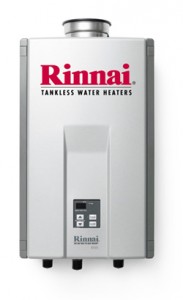
There are a lot of reasons to recommend a tankless hot water heater, ease of maintenance being one of them. But there’s one threat that anyone who owns a tankless heater should be aware of and take the proper steps to avoid: hard water scale buildup, primarily on the heat exchangers. If hard water scale is allowed to build up, the result can be an overheated heat exchanger and the entire system locking up, leaving you and your family without hot water and facing expensive repair bills.
Here’s the lowdown on avoiding problems like this with your tankless hot water heater.
How to Avoid Hard Water Problems
When it comes to preventative maintenance, there are two easy steps you should take to ensure your tankless hot water heater is protected from hard water issues:
- Consider installing a “whole-house” water softener in your home to filter all the water coming into your house at the point of entry. Not only will this decrease the incidence of hard water scale build up in your water heater, but your other appliances, showers, dishwashers, and sinks will also be protected. Plus, your water will taste better!
- Periodically flush your hot water heater (every six to twelve months is usually sufficient).
The second step, flushing your tankless water heater, is easier than you think – you can do it yourself with a little preparation and by following the below instructions.
Flushing Your Tankless Water Heater
First, gather some supplies: you’ll need a small sump pump of about 1/6 HP (you can rent this from a hardware or home improvement store if necessary), two small lengths of hose, two to three gallons of white vinegar and one gallon of water.
When you’re ready to begin,
- Take off the water heater’s cover plate to expose the gas or electric ignition source, and shut off all valves and water connections. Your water heater’s owner’s manual should provide any information you need about performing these operations.
- Turn off all power sources to the water heater, and shut off all water lines and the water inlet and outlet sources.
- Find the overflow valve and open it, allowing the water pressure to be released.
- Take one of the hoses you’ve prepped and connect one end of it to the output connection on the water heater. Then, connect the other end of that same hose to the input connection on the water heater. Take the other hose and connect one end to the output connection, allowing the other end to sit in the bucket.
- Place the sump pump into the bucket and fill the bucket with the water and vinegar. Make sure that the sump pump is fully submerged in the vinegar/water mixture and that the hose coming from the “output” connection is running into the bucket.
- Start the sump pump, and allow the vinegar and water to cycle through the water heater for about 45 minutes to an hour.
This process will remove the limescale and any calcium deposits that have built up inside the water heater. That’s it!
If you have any questions about your tankless hot water heater, or want more info on flushing your water heater yourself, give R.S. Andrews a call today – we’re always ready to help Atlanta homeowners fix (and prevent) plumbing problems!

